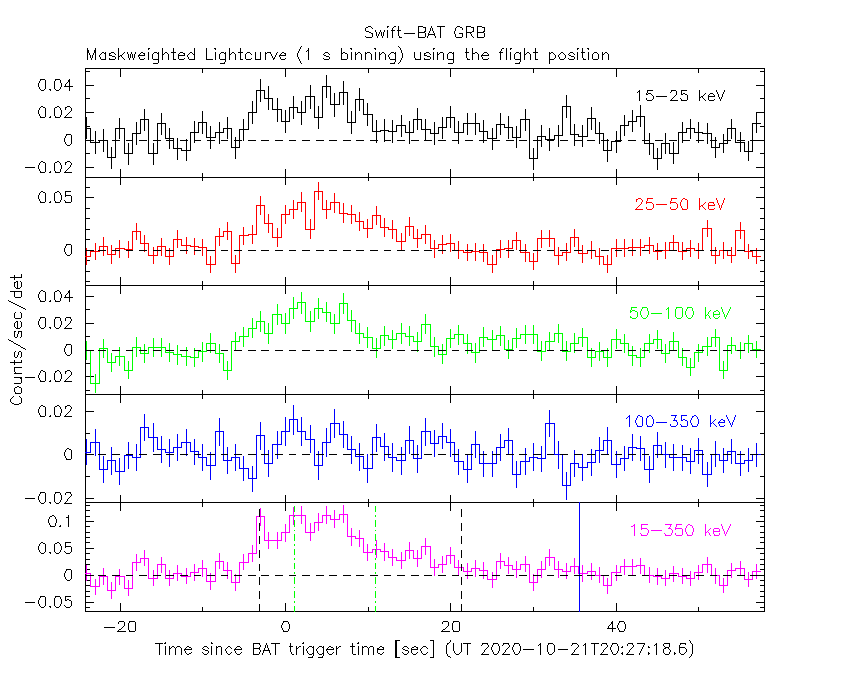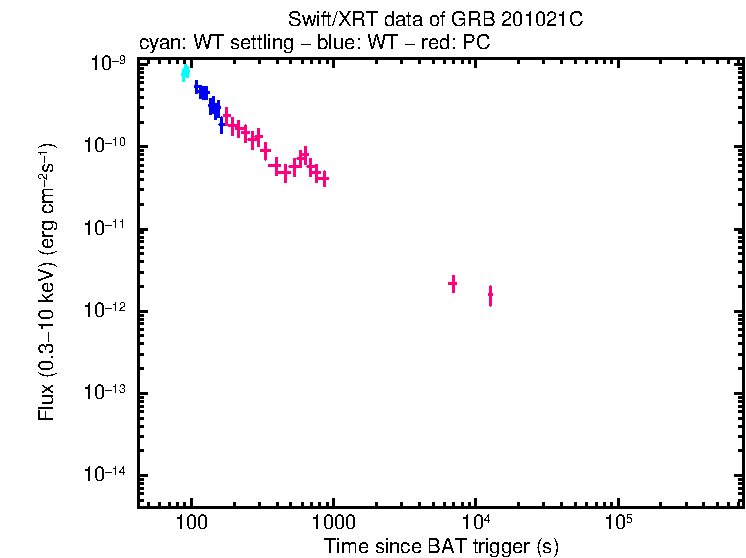
A.Y. Lien (GSFC/UMBC), D.N. Burrows (PSU) and S.R. Oates (U.Birmingham) for the Swift team
At 20:27:18 UT, the Swift Burst Alert Telescope (BAT) triggered and located GRB 201021C (trigger=1001130) (Lien et al. GCN Circ. 28730). Swift slewed immediately to the burst. At the time of the trigger, the initial BAT position was 112° from the Sun (11.1 hours East) and 72° from the 32%-illuminated Moon. Table 1 contains the best reported positions from Swift, and the latest XRT position can be viewed at http://www.swift.ac.uk/xrt_positions.
Lien et al. (GCN Circ. 28730) reported the discovery with UVOT of an optical afterglow. Vielfaure et al. (GCN Circ. 28739) determined a redshift of 1.070 from VLT. Table 2 is a summary of GCN Circulars about this GRB from observatories other than Swift.
Standard analysis products for this burst are available at https://gcn.gsfc.nasa.gov/swift_gnd_ana.html.
As reported by Stamatikos et al. (GCN Circ. 28755),
the BAT ground-calculated position is RA, Dec = 12.503, -55.862 deg which is RA(J2000) = 0
The mask-weighted light curve (Figure 1) shows a single peak running from ~T-5 s to T+20 s, with a broad peak around T+3 s.
The time-averaged spectrum from T-4.19 to T+27.95 s is best fit by a simple power-law model.
The power law index of the time-averaged spectrum is 1.63 ± 0.15.
The fluence in the 15-150 keV band is 1.0 ± 0.1 x 1
The results of the batgrbproduct analysis are available at https://gcn.gsfc.nasa.gov/notices_s/1001130/BA/.
Analysis of the initial XRT data was reported by Burrows et al. (GCN Circ. 28754). We have analysed 4.3 ks of XRT data for GRB 201021C, from 105 s to 58.8 ks after the BAT trigger. The data comprise 62 s in Windowed Timing (WT) mode with the remainder in Photon Counting (PC) mode.
The light curve (Figure 2) can be modelled with a power-law decay with a decay index of α=1.22 (+0.07, -0.06).
A spectrum formed from the PC mode data can be fitted with an absorbed
power-law with a photon spectral index of 1.62 (+0.19, -0.16). The
best-fitting absorption column is 5 (+21, -5) x 1
The Swift/UVOT began settled observations of the field of GRB 201021C 105 s after the BAT trigger
(Oates and Lien GCN Circ. 28745).
A source consistent with the XRT position (Beardmore et al. GCN Circ. 28736) is detected in the initial UVOT exposures.
Table 3 gives preliminary
magnitudes using the UVOT photometric system
(Breeveld et al. 2011, AIP Conf. Proc., 1358, 373).
No correction has been made for the expected extinction in the Milky Way
corresponding to a reddening of

Figure 1. The BAT
mask-weighted light curve in the four individual and total
energy bands. The units are counts

Figure 2. The XRT light curve.
Any data from a crosshatched region are not included in the fit.
| RA (J2000) | Dec (J2000) | Error | Note | Reference |
|---|---|---|---|---|
| 0 |
-55°51'56.8" | 0.42" | UVOT-refined | Oates and Lien GCN Circ. 28745 |
| 0 |
-55°51'55.4" | 1.4" | XRT-final | UKSSDC |
| 0 |
-55°51'55.8" | 1.7" | XRT-enhanced | Beardmore et al. GCN Circ. 28736 |
| 0 |
-55°51'44.0" | 1.3' | BAT-refined | Stamatikos et al. GCN Circ. 28755 |
| Band | Authors | GCN Circ. | Subject | Observatory | Notes |
|---|---|---|---|---|---|
| Optical | Lipunov et al. | 28733 | MASTER optical synchronously observation |
MASTER | |
| Optical | Vielfaure et al. | 28739 | VLT/X-shooter redshift | VLT | redshift |
| Optical | Klotz et al. | 31752 | TAROT Reunion observatory optical light curve |
TAROT | light curve |
| Gamma-ray | Lesage and Meegan | 28748 | Fermi GBM detection | Fermi GBM | Fluence=1.7±0.2x1 (brighter than 26% of long GRBs) |
| Filter | Exp(s) | Mag | ||
|---|---|---|---|---|
| whit |
105 | 255 | 147 | 16.66 ± 0.03 |
| white | 598 | 617 | 19 | 16.22 ± 0.05 |
| v | 647 | 667 | 19 | 16.49 ± 0.16 |
| b | 573 | 593 | 20 | 16.80 ± 0.10 |
| 317 | 567 | 246 | 15.76 ± 0.03 | |
| u | 722 | 742 | 19 | 16.06 ± 0.10 |
| uvm2 | 672 | 692 | 19 | 16.43 ± 0.24 |
| uvw2 | 623 | 643 | 19 | 16.68 ± 0.22 |
Table 3. UVOT observations reported by Oates and Lien (GCN Circ. 28745). The start and stop times of the exposures are given in seconds since the BAT trigger. The preliminary detections and 3-σ upper limits are given. No correction has been made for extinction in the Milky Way.
March 14, 2022